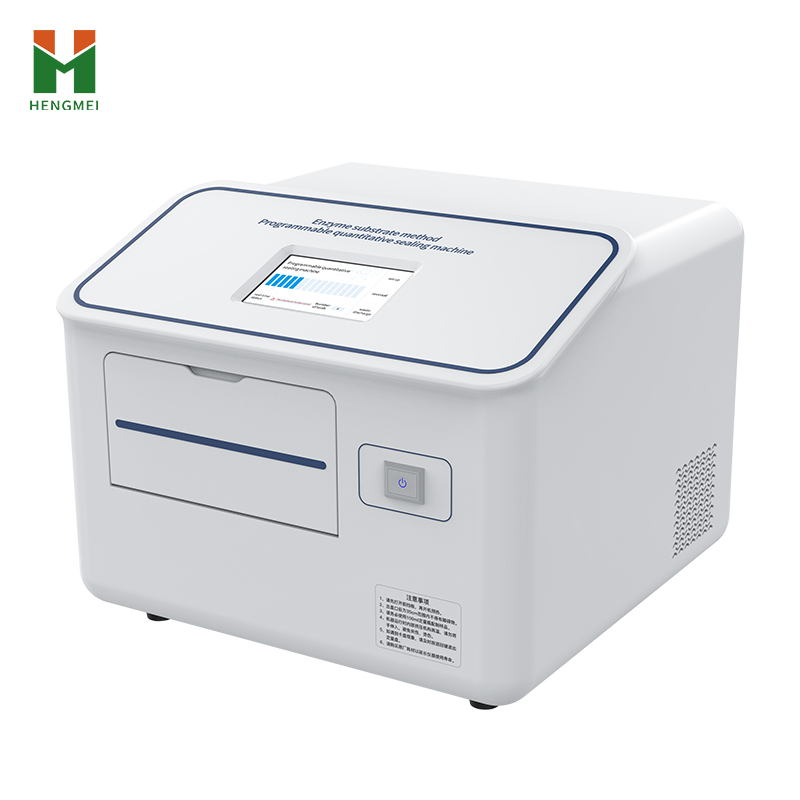Programmable Quantitative Sealer for Enzyme Substrate Method Water Testing
Article Source: Hengmei Technology Release time:2025-10-20 17:57:40
In the field of water quality monitoring, rapid and accurate detection of microbial contamination indicators is directly related to public health. The programmable quantitative sealer, as the core device in enzyme substrate-based testing systems, uses technological innovation to enable rapid, quantitative detection of total coliforms, fecal coliforms, and Escherichia coli in water samples, providing a comprehensive solution for water quality monitoring.

I. Instrument Overview and Importance
The programmable quantitative sealer is an intelligent sealing device specifically designed for enzyme substrate-based microbial testing. It is primarily used to seal 51-well and 97-well quantitative testing plates. Designed and manufactured in accordance with standards such as GB/T 5750.12-2023 "Standard Test Methods for Drinking Water" and HJ 1001-2018 "Determination of Total Coliforms, Fecal Coliforms, and Escherichia coli in Water Quality," this device standardizes and automates water sample microbial testing.
Traditional microbial testing methods require 3-5 days to produce results and have high requirements for the laboratory environment and operator experience. The enzyme substrate method, using a programmable quantitative sealer, can complete testing in just 24 hours, significantly improving efficiency. It is particularly suitable for emergency monitoring and routine large-scale water sample screening. The widespread application of this equipment is crucial for preventing the spread of waterborne diseases and ensuring drinking water safety.
II. Operating Principle and Technical Features
1. Operating Principle
The programmable quantitative sealer utilizes a dedicated heated roller system controlled by intelligent circuitry to accurately seal 51-well or 97-well quantitative test trays. During operation, the filled quantitative test tray is placed in the work area. After setting parameters via the touchscreen, the heated rollers complete the sealing process under program control. The entire sealing process takes only 10-12 seconds, ensuring a consistent seal at each well.
The sealed tray is then placed in a constant temperature incubator for 24 hours. Based on the enzyme substrate method, β-galactosidase produced by total coliform bacteria breaks down the substrate ONPG, causing the culture medium to appear yellow. β-glucuronidase produced by Escherichia coli breaks down the substrate MUG, producing fluorescence. Thermotolerant coliform bacteria also break down ONPG at 44.5°C, producing a yellow color. Quantitative results can be obtained by counting the number of positive wells and consulting the MPN table.
2. Technical Features
• High-Efficiency Sealing Capacity: Sealing time of ≤12 seconds per 51-well and 97-well quantitative trays significantly improves work efficiency.
• Intelligent Temperature Control System: Optimized heating element layout and temperature control algorithm ensure uniform sealing quality.
• Ease of Use: Equipped with an intuitive touchscreen interface, supporting parameter settings and fault self-diagnosis.
• Safety and Reliability: Equipped with multiple safety mechanisms, including overload protection and short-circuit protection.
• Energy-Saving and Environmentally Friendly Design: Preheating time ≤3 minutes, automatic energy saving in standby mode, and housing temperature <40°C.
III. Technical Parameters and Performance Indicators
Sealing Speed: ≤12 seconds per tray, suitable for 51-well and 97-well quantitative trays.
Preheating Time: ≤3 minutes, fast start-up and preparation.
Operating Voltage: AC 220V ±10% 50Hz, standard mains power supply
Noise level: <48dba, low-noise operation
External housing temperature: <40°C, safe contact temperature
Device weight: 14.2kg, portable design
Dimensions: 42×41×33cm, compact design
Operating temperature: -10°C to 50°C, wide operating temperature range
Detection range: 0-2419 MPN/100ml, 97-well quantitative plate with undiluted water sample
Service life: >5 years or 50,000 samples, high reliability
IV. Technical Advantages Analysis
Compared with traditional detection methods, the programmable quantitative sealing machine combined with the enzyme substrate method offers significant advantages:
1. Significantly improved detection efficiency
• Time advantage: Detection time is reduced from 3-5 days to 24 hours
• Ease of operation: Hands-on operation takes less than 1 minute, no specialized aseptic operation skills required
• Batch processing: Suitable for simultaneous testing of large numbers of samples, improving laboratory throughput
2. Significantly Improved Detection Quality
• Low False Positive Rate: Only 0.01%, significantly lower than the 23-26% of the membrane filter method
• Accurate Quantification: Based on the MPN statistical model, the detection range is wide (1-2419.6 MPN/100ml)
• Reliable Results: No validation testing is required, and quantitative results are directly reported
3. Significant Cost-Effectiveness
• Reduced Consumables: No culture medium preparation or extensive glassware sterilization is required
• Lower Requirements: No cleanroom environment required, and operation can be performed in an ordinary laboratory
• Reduced Labor: Simple training is required, reducing the need for specialized technicians
V. Application Areas and Solutions
1. Main Application Scenarios
• Drinking Water Monitoring: Water plant effluent, pipe network terminal water, and secondary water supply testing
• Environmental Water Monitoring: Surface water and water source water quality monitoring
• Emergency Monitoring: Rapid assessment of sudden water pollution incidents
• Special Industry Water Use: Water testing for food processing, medical water, and livestock farming
• Wastewater Treatment: Monitoring the influent and effluent quality of wastewater treatment plants
2. Industry Solutions
The programmable quantitative sealer provides complete testing solutions for various application scenarios:
• Supporting reagent system: Dedicated MMO-MUG culture medium and quantitative test plates
• Method validation support: Provides complete method validation and comparison data
• Training services: Operator training and technical support
• Quality management: Provides quality control solutions and data analysis support
As the core equipment for enzyme substrate testing, the programmable quantitative sealer achieves rapid, standardized, and automated water microbial testing through technological innovation. Its excellent performance, simple operation, and reliable output make it a valuable tool in water microbial testing.
Address of this article:https://www.kjhm.net/news/789.html
 Related News
Related News
-
11 / 2024-05
Multi Parameter Water Quality Detector Ensures Water Quality Safety.
Learn more
-
26 / 2024-11
Microwave digestion instrument: an efficient and environmentally friendly sample pretreatment tool.
Learn more
-
22 / 2024-10
Enhance Dairy Excellence With Our Rapid Milk Analyzers.
Learn more
-
09 / 2024-12
Luminescent bacterial biotoxicity detector for water quality monitoring to provide scientific evidence.
Learn more



 Current
Location:
Current
Location:





